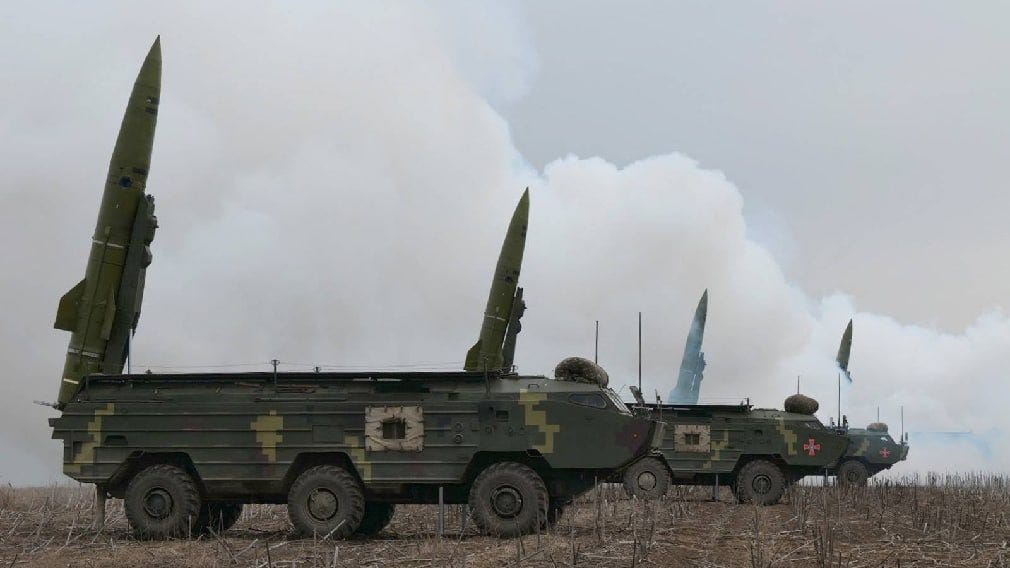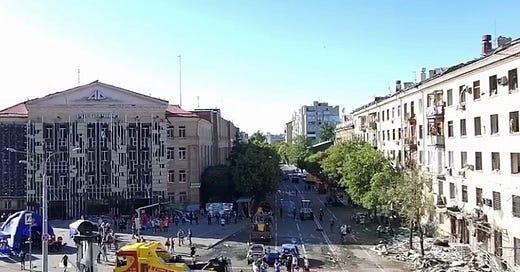Hello everybody!
Yesterday around 15.30hrs local time, a Russian Su-34 deployed four UMPB D-30 (their small diameter bomb) to strike Kharkiv. Yup, the city of Kharkiv. And then not some kind of industrial facilities, military base or anything like ‘dual use’ facility, but: a crossroad in the centre of Kharkiv, with a row of low buildings with small shops (Ukraine is not yet in the EU, so it still has local groceries and other small shops), surrounded by dozens of tall apartment buildings…
As far as is known by now, at least three people have been killed, at least 56 injured – of whom 16 were hospitalised and 4 are in critical condition.
Coming less than 24 hours after the Russian strike on the National Technical University of Oil and Gas in Ivano-Frankivsk, and about 40 hours after a strike by an Iskander-M ballistic missile on food warehouses in Kryvyi Rih, this is making it clear: such attacks are no mistake, no technical malfunctions of weapons in question, no debris and no ‘Ukrainian exaggerations’ or whatever – but intentional.
Of course, anybody still thinking in style of ‘the Russians would never do that’ – is alwasy free to explain me what kind of fucking ‘military facility’, ‘Azov-Nazi base’, ‘Laboratory for development of Atomic-, Biological- and/or Chemical weapons’, (or whatever other nonsense are Moscow and all the possible Pudding-fans in the West babbling as ‘reasons’ for this war), should there be at the joint of the Vernardskoho Street and the Gagarina Avenue, in the centre of Kharkiv?
The Levada Railway station? Sure, this is perhaps 150 metres away, but: what kind of ‘military’ target should a station used for commuter transportation be? The ‘Militaryst’ clothing store, 150 metres north of the crossroad? So, the ‘UkroNazis’ are now prohibited from buying latest military fashion and related gear, too?
Or was it another of ‘well-proven as highly reliable’, but actually corrupt FSB-informants who provided ‘intelligence’ about ’50 NATO generals in a bunker 900 metres under the Hotel Trempel’, and similar BS…?
Well, if so, then why not deploying one of ‘super-turbo-precise’ weapons like Iskander-M or this fantasy about ‘UMPK on FAB-3000M-54’?
And, if nothing of that: what kind of ‘military’ is it that’s deploying weapons that are missing by 150 metres to strike any kind of a target in the centre of a big urban area….?
….indeed, this entire strike on Kharkiv was ‘so much unintentional’ that today Pudding’s PRBS-industrialists and fans in the West ‘must’ spread PRBS like videos purportedly showing ‘Ukrainian ATACMS-strike on a beach full of civilians’…
***
Yes, I’m disgusted and upset over this atrocity – just like I’m upset and disgusted about so many earlier atrocities in this war, and about any other atrocity in any other war. Indeed: I’m furious about any kind of atrocities. But, that’s just me and what do I think doesn’t matter.
What really matters in this case is: how to stop this?
Well, for the start, ‘negotiations’ - with Pudding - are not working.
Therefore, the mass of people is going to draw a ‘logical’ conclusion and say something like, ‘bolster (air/anti-ballistic-) defences of Kharkiv’. However, after more than two years of constant bombardment of the second largest city in Ukraine, I think it’s obvious that this is no durable solution.
It’s like a heart surgery: patches up the heart and makes it beat for few months to few years longer…
….while the actual solution is to keep that heart in good health.
And in this case, ‘keeping that heart in good health’ means to develop capability of quickly, precisely, and decisively, detecting and targeting launchers – preferably before these can fire their weapons… at Kharkiv, for example.
That is something that requires offensive action: the kind of action we’ve seen two days ago, when Ukrainian long-range UAVs hit the 726th Training Centre and a storage site for Shahed attack UAVs, in Leysk, Krasnodar, in Russia.
Why is that so?
Because, if one hits the storage sites or launchers, or air bases BEFORE the enemy actually can deploy these, ‘fire’ missiles or load UMPKs on its aircraft, one is fighting a war in the most economical way, too. Instead of waiting for such weaponry to be released, and then hunting them down one after the other, one can even destroy dozens of enemy weapons at once, with a single blow. Foremost: one is preventing enemy from causing any kind of damage – whether to Kharkiv or any other place.
Thus, the actually logical question is: what does Ukraine need to become capable of targeting ‘launchers’ (or ‘platforms’ that are serving as launchers)?
It might sound laughable to many – even like a ‘fantasy’ – but: the starting point would be early warning satellites. And then not ‘any’ satellites, but satellites capable of detecting at least the missile launches (like US-made SBIRS system). Even better would be satellites capable of detecting missile launchers before they can launch their missiles. And of course: satellites capable of tracking the work of Russian air bases.
All the intelligence collected by such platforms and other means of intelligence gathering would then have to be rapidly forwarded to one, centralised command system, which would control multiple units equipped with not just ‘hundreds’ but ‘thousands’ of ballistic missiles with a range of at least 500, better 1000km.
***
Now, those that know something about this topic are now going to say, 1.) ‘hey, Tom is now thinking in direction of the RUK concept of the Russian General Staff (GenStab)’. And, those that know about the RUK, but are something like ‘proponents of air power’, are going to say something like, 2.) ‘no, Ukraine does not need ballistic missiles, but a strong air force that can then bomb the launchers’….
1.) Yes, I am thinking in direction of the RUK concept. Therefore, I’ve got to explain at least its basics, too. RUK is a Russian abbreviation for razveyvatelno-udarnnyy komplekx: reconnaissance-strike complex (a good explanation of can be found in the PDF here). It’s a concept along which all the command, control, communications, computers, intelligence, surveillance, and reconnaissance are centralised to provide intelligence enabling the command node in question to bring quick decisions, and then act quickly, decisively and with precision. Usually by the means of tactical ballistic missiles: ideally such like Iskander-M (together with UAVs like Zala and Orlan, this is the centrepiece of the RUK complex), but – due to the shortage of same – often with such like Tochka-U, cruise missiles, or even S-300 SAMs.
With other words: the RUK concept demands the armed forces to be capable of quickly detecting and tracking crucial targets, and then targeting these with weapons deployable in a matter of minutes and possessing the necessary precision.
Why that? Because the target in question might move, or contact to it might get lost, or the enemy might recognize that the object in question is under threat and then bolster its defences. Thus, the speed of decision-making and the speed of attack are decisive to improve the chances of actually destroying the target.
2.) Why by ballistic missiles and not by an air force (or other, similar means)?
Because, modern-day tactical ballistic missiles are deployable in a matter of minutes, and – once fired – are reaching their targets in a matter of minutes, too. In comparison, an air force would first have to set up all the support aircraft, then plan the operation, brief pilots, arm aircraft, and then actually fly such an operation – all of which is usually taking ‘hours’ (at least… if not ‘days’). And even if one operation is successful, and 1, 2, or 5 launchers are hit: there’s still no guarantee all the launchers would get hit. Moreover, an air force is far more expensive to acquire, maintain, train, and operate than a force operating ballistic missiles (or hypersonic missiles, or cruise missiles, or attack UAVs).
While… well, just think of it: if one has the ability to a) hit depots for ballistic- or cruise missiles, b) detect and track launchers, and actually hit them before they can fire, and/or c) at least shortly after they have fired…things are looking dramatically different.
Why ‘thousands’ of ballistic missiles? Because one can keep their design simple enough to make them cheap and affordable while, if one fires enough of them, some are always getting through, regardless how good are enemy air defences. There is, simply, no ‘perfect’ anti-ballistic defence.
Finally, there is one more reason for this way of thinking: it’s called ‘precedent’.
Arguably: after fiddling around with the RUK concept for nearly 30 years, and wasting significant sums of money, the Russian Armed Forces have - ‘finally’ - made it work, early this year. Nowadays their reconnaissance UAVs are roaming deep behind the Ukrainian frontlines: searching for HIMARS-launchers or Ukrainian air defence systems. OK, the VSRF’s command nodes are slow, and thus it often takes them hours to actually fire an Iskander.
But, when they hit…
Actually, Ukrainians have proven much better in this business, already two years ago. See the situation in the Czernihiv area of late February 2022, where the Ukrainian 19th Missile Brigade was demolishing one column of the Russian 41st Combined Arms Army with strikes by single Tochka-U ballistic missiles, after the other… tragically for Ukraine, its stocks of Tochkas are long since gone…

Or, and even better, see the Black Sea: back in February 2022, the Black Sea Fleet imposed a blockade of the Ukrainian coast, including ports exporting food. Was bad for Ukrainian economy, caused a major crisis on the international plan etc., and all the negotiations with Moscow were in wain. The only thing that worked was: attack Russian warships maintaining that blockade. 20+ Russian warships sunk, destroyed, or badly damaged later – and there is no Russian naval blockade left: Ukraine is exporting its produce almost at will. Of course: it must constantly de-mine its territorial waters, and keep a watchful eye on the Black Sea Fleet, but: in grand total, it scared the Russians so much that that’s the least of all problems caused by the ‘Russian naval blockade’. And, best of all: the Russians have understood the ‘message’, too - which is why they’re not even trying to enforce that blockade.
Therefore, it’s about the time to find a similar solution for all the Russian strikes on Ukrainian civilians. And then bring it to bear, as soon as possible.
BTW: that would solve the problem with re-supply of (very expensive) surface-to-air missiles and surface-to-air missile systems for Ukrainian air defences, too – and that once and for all.
….but would be ‘bad for business’ of all too many big corporations from the ‘defence sector’ – which is why the West is not going to help this become possible.
Which in turn means: like in so many other cases related to this war, there will be no solution for this problem until the Ukrainians take things into their own hands, and develop their own solutions. Ukraine has the means, the know-how and the tools: it’s certain to take it time and lots of money, but it simply has no other solution but to act.
The sooner, the better.





I would like Sullivan to visit Kharkiv or the same village where Steinmeyer in 2022 had to sit underground in the same place the poor Ukrainians were held as hostages. Or to see children and young men crippled by this war. I wish him to be frightened out of his wits.
Thank you for the update. I understand the logic of what Ukraine needs to do. This will take some time. Just wondering is this something that should be prioriteres above Sead/Dead tactics against Russian airdefenses?